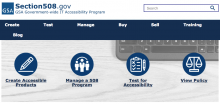You are here
Is your library website accessible to all?
Posted by Jim Craner on December 3, 2018
As a librarian, you naturally want to ensure that your library is accessible to patrons of all ages and abilities? We build ramps and elevators for people who use wheelchairs, scooters, and other mobility assistants to make sure they have access to every resource in our library.
Are you taking the same care to make sure that all of your patrons can access the resources on your website?
If you've been in charge of a website redesign in the past decade, you're already familiar with the concept of website accessibility - ensuring that people of all abilities using many kinds of assistive technology can use your website. The most common example of website accessibility is ensuring that your site is compatible with screen-reading software -- in fact, many libraries provide computers equipped with this software for priority usage by patrons with visual impairments. Using a screen reader is challenging -- but a thoughtful web developer/designer can build a site that is friendly to *all* patrons no matter if they are reading the site or hearing it narrated by a computer voice.
Every aspect of design can be affected by accessibility concerns. For instance, a new set of colors for map infographics was recently released so that people with color blindness can still accurately see the differences in color shading easily. And vision isn't the only issue that can interfere with usage of a website and other online services. Have you ever had trouble clicking on a tiny button on a website? Imagine having limited motor control using a traditional mouse and how much tinier that button would seem!
These days, the specific technologies and requirements used in accessibility design can be rather complex -- as a librarian, you don't need to become an expert in every single compliance requirement and accessibility HTML tag. Instead, just be aware of the general topics and ensure that compliance is a high priority for your web designers and development team. Here are some useful links to learn more:
Section508.gov - a federal government website describing the US Section 508 website accessibility guidelines and providing a wealth of resources for helping ensure your website or application is compliant.
"Creating Accessible Online Resources for People With Disabilities" is a Tech Soup webinar presented by Jayne Cravens of Knowbility, a leading organization that provides information and services around online accessibility issues.


